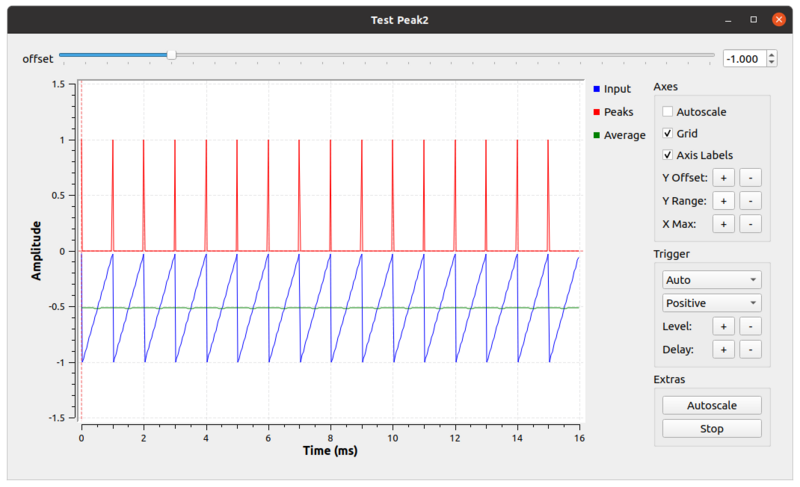Peak Detector2: Difference between revisions
Jump to navigation
Jump to search
No edit summary |
(add example flowgraph and output) |
||
| (One intermediate revision by one other user not shown) | |||
| Line 2: | Line 2: | ||
Detect the peak of a signal. | Detect the peak of a signal. | ||
If a peak is detected, this block outputs a 1, else it outputs 0's. | If a peak is detected, this block outputs a 1, else it outputs 0's. A separate debug output may be connected, to view the internal estimated mean described below. | ||
== Parameters == | == Parameters == | ||
| Line 8: | Line 8: | ||
; TH factor rise (''R'') | ; TH factor rise (''R'') | ||
: Determines when a peak | : Determines when a peak is present. An average of the input signal is calculated (through a single-pole autoregressive filter) and when the value of the input signal goes over threshold_factor_rise*average, we assume we are in the neighborhood of a peak. The block will then find the position of the maximum within a window of look_ahead samples starting at the point where the threshold was crossed upwards. | ||
; Look ahead (''R'') | ; Look ahead (''R'') | ||
: Used when the threshold is found to look if there another peak within this step | : Used when the threshold is found to look if there another peak within this step range. | ||
; Alpha (''R'') | ; Alpha (''R'') | ||
: | : One minus the pole of a single-pole autoregressive filter that evaluates the average of the input signal. | ||
== Example Flowgraph == | == Example Flowgraph == | ||
This flowgraph can be found at [https://github.com/gnuradio/gnuradio/blob/master/gr-blocks/examples/peak_detector2.grc]. | |||
[[File:Peak_detector2_fg.png|800px]] | |||
== Example Output == | |||
[[File:Peak_detector2_out.png|800px]] | |||
== Source Files == | == Source Files == | ||
Latest revision as of 14:13, 9 March 2021
Detect the peak of a signal.
If a peak is detected, this block outputs a 1, else it outputs 0's. A separate debug output may be connected, to view the internal estimated mean described below.
Parameters
(R): Run-time adjustable
- TH factor rise (R)
- Determines when a peak is present. An average of the input signal is calculated (through a single-pole autoregressive filter) and when the value of the input signal goes over threshold_factor_rise*average, we assume we are in the neighborhood of a peak. The block will then find the position of the maximum within a window of look_ahead samples starting at the point where the threshold was crossed upwards.
- Look ahead (R)
- Used when the threshold is found to look if there another peak within this step range.
- Alpha (R)
- One minus the pole of a single-pole autoregressive filter that evaluates the average of the input signal.
Example Flowgraph
This flowgraph can be found at [1].
Example Output
Source Files
- C++ files
- TODO
- Header files
- TODO
- Public header files
- TODO
- Block definition
- TODO

